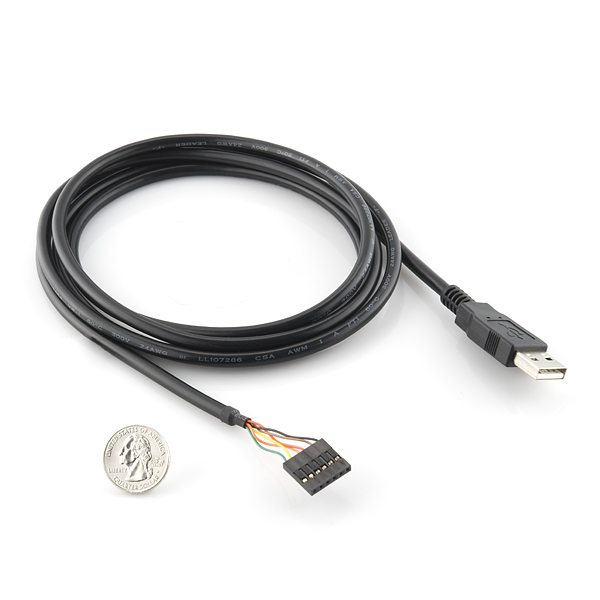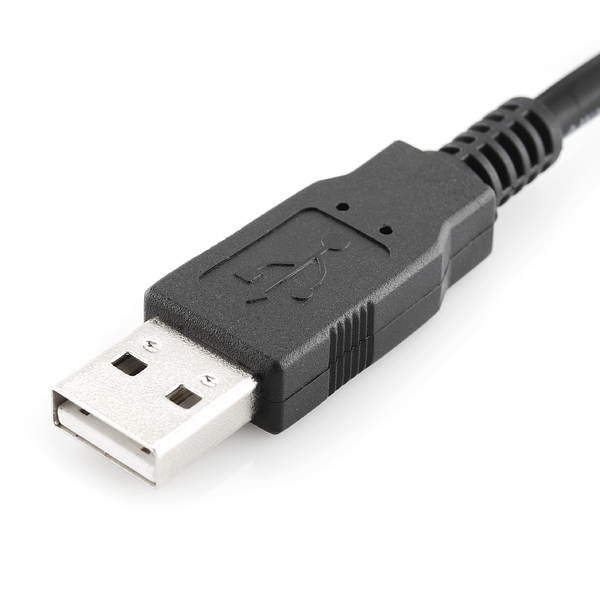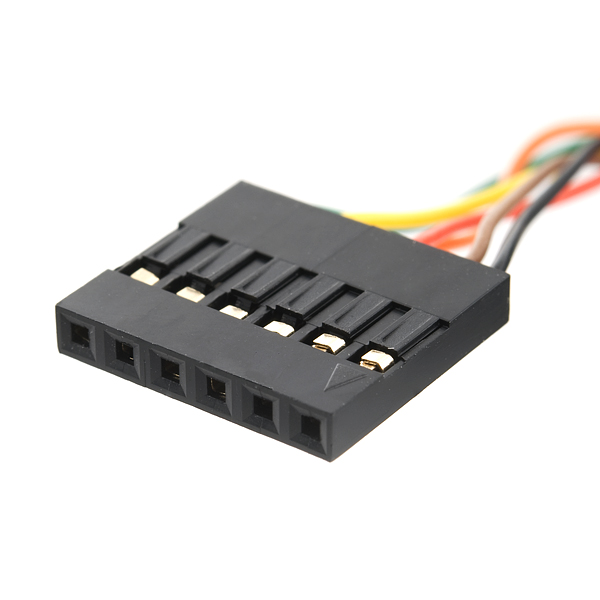The FTDI cable is a USB to Serial (TTL level) converter which allows for a simple way to connect TTL interface devices to USB. The VCC pins of this FTDI cable are configured to operate at 5V with 3.3V I/O.
The FTDI cable is designed around an FT232RQ, which is housed in a USB A connector. The other side of the cable is terminated with a 0.1" pitch, 6-pin connector with the following pinout: RTS, RX, TX, 5V, CTS, GND (RTS is the green cable and GND is black).
This cable has almost the same pinout and functionality as our FTDI Basic Breakout board; you can use it to program your Arduino Pro, Pro Mini and Lilypad, etc. For use with those boards, align the black and green wires of the FTDI cable with the 'BLK' and 'GRN' labels on the PCB. The difference between this cable and the FTDI Basic Breakout is the cable has a 5V Vcc where as the breakout has a 3.3V Vcc. You will still be able to program an Aruidno Pro, Pro Mini, Lilypad, etc. The 5V Vcc supply will not damage these Arduino circuit boards.
Originally, the cable was designed to have 3.3V VCC, however something was lost in translation between SparkFun and our supplier and we got stuck with a whole bunch of FTDI cables that have a slight mix up in wiring. These have 5V VCC, and 3.3V I/O. The 5V Vcc output shouldn't be a problem unless this cable is being used to power a sensitive circuit such as a sensor.
There are pros and cons to the FTDI Cable vs the FTDI Basic. The FTDI Basic has great LED indicators, but requires a Mini-B cable. The FTDI Cable is well protected against the elements, but is large and cannot be embedded into a project as easily. The FTDI Basic uses DTR to cause a hardware reset where the FTDI cable uses the RTS signal.
FTDI Cable 5V VCC-3.3V I/O Product Help and Resources
Connector Basics
January 18, 2013
Connectors are a major source of confusion for people just beginning electronics. The number of different options, terms, and names of connectors can make selecting one, or finding the one you need, daunting. This article will help you get a jump on the world of connectors.
How to Install FTDI Drivers
June 4, 2013
How to install drivers for the FTDI Basic on Windows, Mac OS X, and Linux.
SparkFun USB to Serial UART Boards Hookup Guide
February 18, 2016
How to use the SparkFun FTDI based boards to program an Arduino and access another serial device over the hardware serial port, without unplugging anything!
Comments
Looking for answers to technical questions?
We welcome your comments and suggestions below. However, if you are looking for solutions to technical questions please see our Technical Assistance page.
Customer Reviews
4.3 out of 5
Based on 11 ratings:
1 of 1 found this helpful:
Works as advertised.
Need a terminal for a Beaglebone or Arduino derivative as mentioned- but don't have the footprint/profile for the breakout board (it is possible...it's why I had to buy several of these gems over time...)? This is your answer to that "problem" with the breakouts.
1 of 1 found this helpful:
Perfect
I bought this to use in conjunction with a BBB for BIOS flashing via SPI. Works great!
2 of 3 found this helpful:
sigh
So after blowing 2x ESP8266 modules, i put a voltage meter on the VCC cable and saw the 5v output... nearly ready to lose me *****.... i read the item discription again and saw the forewarning that this cable outputs 5v..... sigh
Dont make the same mistake i made! get a voltage regulator if you plan to use this cable with a 3.3v device!!
It Works
It's an FTDI cable...need I say more?
Pretty good
The cable works as advertised. I only wished that the power was at 3V3 like the logic. But that issue was described on the product page. I has several of these and will continue to buy them till such time as the power issue is corrected.
As advertised
Works great, no complaints
Extremely useful!
Having proper 5V USB, but being able to communicate with 3.3V microcontrollers is hugely useful.
3.3 OR 5V?
I got this to communicate with the Arduino Fio and have since used it with the RN52 breakout, and a few other projects. Has been handy as heck. The only downside i see in the future is that the wires going to the 6-pin connector are twisted around one another and seem to be the point that will ultimately fail. But I don't have a fix for it so i reckon they did as food as could be asked.
Great cable, a bit expensive.
I'd put this cable at just okay especially if you compare it to the other ftdi cables and boards Sparkfun sells.
cons:
1) You can't power a 3.3v device from it.
2) It's more expensive then the other sparkfun cables (eg CAB-12977 is half the price). It seems weird to me that you pay such a premium for having a few extra handshake pins broken out.
Pros:
1) In spite of con the cons The fact that the handshake pins are there and the fact that the electronics are not exposed, making it a bit more durable is absolutely worth it for me.
2) The FTDI chip is much more reliable than the prolific chips, which I've had flake out on me.




Just wanted to say that this is a great board to use with a Pi Zero. The 5v VCC will power the board and the I/O is at the 3.3v that the Pi needs. Just connect up VCC to pin 4, GND to pin 6, RXD to pin 8 and TXD to pin 10 and use your favorite serial program to connect at 115200 baud. This also works with other Pi boards as well, though I'm not sure if the bigger boards can source enough power from this cable or not.
Hi,
Would this work with the Propeller P8X32A Breakout ?
When I got this product I was surprised to see a sparkfun logo molded into the boot. You guys are getting fancy.
How long have you guys had these things? I'd suggest moving them to a broader prototyping category for sure. They're damn convenient for a lot more things than just arduino. I don't think you meant to hide them from the rest of us.
I'm trying to use my Sparkfun branded (molded SF logo in plug) FTDI cables and they're not getting detected by Windows drivers. Upon inspection, my FTDI cables have had their USB PIDs reset to 0000. This is a problem that others online have had, apparently because of knock off FTDI chips being used. There are instructions on resetting the PID which I'm trying now. Sparkfun, any comment on this?
From FTDI Drivers and Counterfeit Chips:
Hi,
Someone in catalog noticed this comment. I haven't heard of any issues with this particular product before. From our tests before with this product (including several other FTDI chips populated on boards), they should be populated with genuine FTDI chips.
will this cable work with a beaglebone black?
Yes - Be sure to align pin 1 of the cable which is the black (ground) wire to pin 1 on the J1 Serial Header which is designated by a white dot. You don’t have to worry about the 5V Vcc on pin 3 of this FTDI adapter as pin 3 on the BBB is not connected.
Works great with my old YellowJacket boards. I also note that on my Beablebone Blacks (the reason I bought 2 of these) the power not connected so you can happily use these with the BBB.
Will this show up as an FTDI device when USB is plugged in, even if the breakout side is not plugged into anything? On the Redboard for example, it will show up specifically as a UART IC, but that's because it is wired in that configuration. Does that mean it wouldn't be recognized if it wasn't connected to any external circuit?
This is an excellent interface cable that is easy to use with very flexible end-user configurable options. Just one precaution, though. Don't change to the external clock setting. It has no external clock components and the cable will be rendered useless, as it is at least. I intend this cable as an interface to program JP1.2/3 remote controls. And, in that use the 5VDC VCCOUT is of no consequence. The VCCIO lines supply 3.3VDC TTL signals. When I needed it, it was on sale for $11 and at that price it was a fantastic deal.
So will this be able to register serial communication from an Arduino Mega's alternate serial ports properly? The Mega runs at 5V logic, but I was wondering if I could use this cable to simply pipe the output from my Mega's Serial1 port to my computer's USB port.
What's the point of this cable? Why are you selling it?? I just fried a $40 sensor because any sane person would assume that a cable labeled/moulded 3.3V would deliver 3.3V Vcc.
Hi , i didn't understood if the cable is compatible with arduino pro mini or the "FTDI Basic Breakout"
will it work with arduino pro mini as it is or i would need to connect another capacitors and resistors?
What might I expect for a maximum current from this cable? In my application, I have a peripheral 3.3 volt device that may draw up to 1.2 A but it has a variety of settings. I can limit the current in the device so that I might experiment while source it through this cable.
Can you check the schematic link ?
not have the cable that is transparent and brings LED indication of tx and rx
Taking a quick peek at the ft232r datasheet ( http://www.ftdichip.com/Support/Documents/DataSheets/ICs/DS_FT232R.pdf ) it states that any IO must be below VCC+0.5V. Does this mean that I can connect it to a 5V i/o device or are the levels too low for that? It seems to me like I shouldn't be able to damage the cable, since there are 10k resistors between the 3.3V regulator and the UART pins.
edit. Saw the other question on 5V, however, I'm still curios of where the problem is.
I need a usb to ttl cable. I need RX, TX, GND and the most important: a pin to control ZERO CROSSING, since my purpose is to connect a pc through usb to XM10e (ttl-cmos) and so be able to send X10 commands through europe wire system.
What cable do I need? Thank you so much for your help, since as you see, I'm bit noob :)
The X-10 transceiver will provide you with a zero-crossing detection signal, which you'll need to synchronize your transmission to. You could use the CTS line on this cable to get that signal back to your computer. Since you're a noob (nothing wrong with that!), be aware that this kind of "raw" X-10 communications requires a bit of timing finesse to pull off. To make your life easier, you might look into other X-10 transceivers that handle more of the job for you, such as the Powerlinc modem from Smarthome. (This is for US power systems, but you may be able to find the same or a similar product for Europe.) Good luck!
It would be nice to have a version terminated with the type of jumpers that will fit on header pins. Since these are 3.3 v they are likely used with development boards or custom boards.
Ideally, there would be six jumpers having the same colors documented in the schematic. An adapter jumper that would mate with the existing inline connector would also work.
I made my own but did not have all the right colors.
John
is this good to use with 3.3v board and 5v board?
This is for 3.3V logic boards, for 5V you need to go with the 5V cable. You can use an FTDI Basic and utilize the solder jumper on the back to switch between 5v and 3.3v.
I can't get this to work. w7 keep throwing "Windows has stopped this device because it has reported problems. (Code 43)" at me.
Tried FTDI installer/files and no luck. When updating,state I already ahve the latest...
what's wrong with that cable?
nvm,problem found. My embeded USB hub in the front pannel is busted. threw it to the back one and it's fine now.
n00b?: if I want to program an atmega328 on a breadboard do I use this? Or the ftdi cable? Or both?? Same questions if I am trying to program an arduino pro mini?
Yes, you can use this. This IS the FTDI cable. You could use this or the FTDI basic. They both do the same thing, they are just in different form factors.
And yes, same question and answer for programming a pro-mini.
Hi,
So I have been using this cable with my Fio, and I just noticed with this plugged in the 3v3 pin on shows 5 volts. Is that a problem? I see above that it mentions this cable won't damage Arduino Pro, which is also 3v3 for vcc, right? Is the 3v3 mainly just important for the level on the rx/tx lines?
Thanks!
Justin
can somebody suggest a method to convert this to 3.3V Vcc. I'm using this to connect to the Razor 9DOF and it requires 3.3V Vcc
I know this is old but my solution is to pull the VCC out of the socket (you can do it without damaging anything if you're careful) and plug it in to a pin added to the external supply input. That way the 5V from the USB will go through the nice onboard 3v3 regulator.
Buy the 3.3v version from mouser: 895-TTL-232R-3V3
-Taylor
The El Cheapo solution would be a resistor divider, the true solution would be a regulator. Both of which are going to be tough to work elegantly into the cable.
Can I use this cable to configure an Xbee PRO?
You probably could. Although you will be much better off using the XBEE explorer board:
http://www.sparkfun.com/commerce/product_info.php?products_id=8687
Thanks for adding this!
Is it possible use for bit-bang programming?
skystorm: indeed it is, though you'll be limited to 4 bits when using this or the basic breakout board. The BOB-00718 (full breakout board) can bang all 8 bits, but then lacks the convenience of directly interfacing to certain Arduino boards and other things that use the same pinout (some XBee adapters, serial RFID readers, etc.)